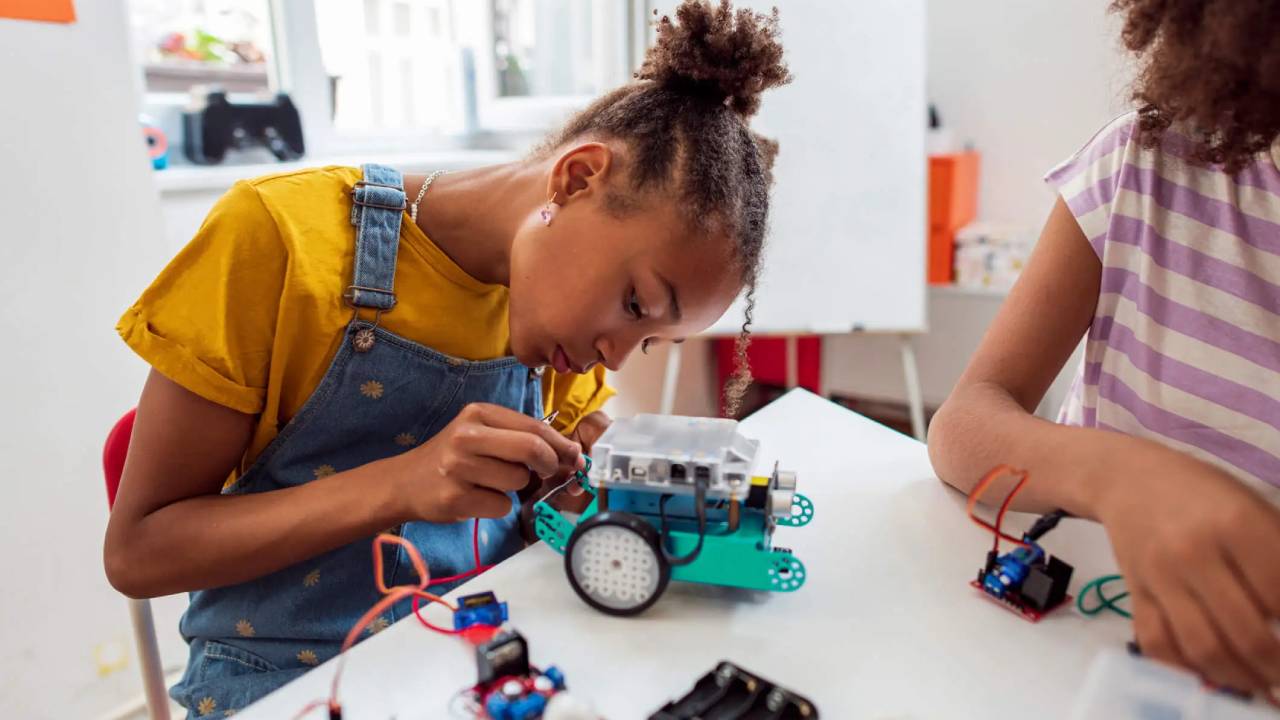Robotics for Kids: A Complete Guide for Parents
Nurturing Innovation and Learning in the Exciting World of Robotics

In this comprehensive parent’s guide on Robotics for Kids, we embark on a journey to unravel the exciting world of technology and innovation tailored for the younger generation. As parents, fostering a love for learning in our children is paramount, and introducing them to robotics early on can be a game-changer.
The importance of integrating robotics into their educational experience cannot be overstated. Beyond the realm of mere gadgets, robotics serves as a dynamic tool for honing essential skills and nurturing creativity in young minds. From critical thinking to decisive reasoning, the advantages of learning mechanical technology quite early on are complex.
In this article, we will dive into the groundbreaking effect of mechanical technology on kids, investigating the enrapturing parts of the field as well as molding the future trailblazers and designers of tomorrow’s potential.
Go along with us as we explore the thrilling prospects that mechanical technology for youngsters brings, furnishing guardians with significant experiences and assets to set out on this instructive experience with their kids.
Getting Started with Robotics
Embarking on the exciting journey of Getting Started with Robotics for Kids is an adventure that promises not only technological exploration but also a profound development of crucial skills in young minds.
As guardians, acquainting our kids with the universe of mechanical technology establishes the groundwork for a future loaded with development and inventiveness.
In this part, we guide you through the underlying strides of this improving system, from choosing the right mechanical technology unit for your kid to making a devoted mechanical technology work area at home.
Let’s dive into the world of possibilities that robotics for kids brings, ensuring a seamless and engaging introduction to this captivating field.
Choosing the Right Robotics Kit for Your Child:
Choosing a suitable advanced mechanics pack is a vital stage in sustaining your kid’s advantage in innovation. The market is overflowing with choices, going from fledgling amicable packs to further developed ones. Think about your youngster’s age, interests, and expertise level while going with a decision.
Opt for kits that provide a balance between challenge and fun, allowing gradual skill progression. Look for user-friendly components and clear instructions, ensuring an enjoyable learning experience. Popular choices include kits that integrate programming with building, offering a holistic introduction to the world of robotics.
Setting up a Robotics Workspace at Home:
Creating a dedicated space for robotics activities not only enhances the learning environment but also adds an element of excitement to the process.
Choose a well-lit and comfortable area, preferably away from distractions, where your children can immerse themselves in hands-on projects.
Organize the workspace with labeled storage for components, ensuring easy access to materials during projects. Consider investing in a sturdy table and comfortable seating to facilitate extended periods of engagement.
Additionally, having a computer or tablet nearby for programming tasks adds a digital dimension to the workspace. By establishing a well-equipped and organized robotics corner at home, you set the stage for a seamless and enjoyable learning experience for your child.
Basic Concepts in Robotics Explained
Embarking on the exploration of Basic Concepts in Robotics for Kids opens a world of wonder and discovery. Understanding the fundamental elements that drive robotic systems lays the groundwork for a deeper engagement with technology.
In this section, we unravel the mysteries behind motors, sensors, and programming, offering a beginner-friendly guide to these essential concepts.
As we demystify the building blocks of robotics, young enthusiasts will gain valuable insights into how their creations come to life, fostering a passion for innovation and problem-solving.
Understanding Motors and Sensors:
At the heart of every robotic creation are motors and sensors, the dynamic duo that empowers movement and interaction. Motors serve as the powerhouse, transforming electrical energy into mechanical motion. As your child explores the fascinating realm of robotics, they will encounter various motors, each designed for specific functions.
Understanding the principles of how motors work and their diverse applications will spark creativity and open avenues for designing robots that move in unique and exciting ways. Complementing motors, sensors act as the eyes and ears of a robot, detecting and responding to the surrounding environment.
From light and touch sensors to infrared and ultrasonic sensors, each type introduces new dimensions to the world of robotics, enabling creations that can adapt and interact intelligently with their surroundings.
Introduction to Programming for Kids:
Programming is the language that breathes life into robotics, allowing young minds to orchestrate their creations with precision. Introducing kids to the basics of programming is a crucial step in their robotics journey.
Visual programming languages designed for children, such as Scratch or Blockly, provide a user-friendly interface for coding without the complexity of text-based languages.
Through simple drag-and-drop commands, kids can learn to sequence actions, control motors, and respond to sensor inputs, all while gaining a fundamental understanding of coding concepts.
Programming not only enhances technical skills but also cultivates logical thinking and problem-solving abilities, laying a solid foundation for a future in STEM fields. As we delve into the world of programming, young enthusiasts will find that creating a robot is not just a task but a journey of imagination and innovation.
Fun and Educational Robotics Activities
Dive into the exciting realm of Fun and Educational Robotics Activities for Kids, where learning meets play, and innovation knows no bounds. As we embark on this adventure, the aim is to make the world of robotics accessible and enjoyable for young enthusiasts.
In this section, we unfold the magic of hands-on experiences through building simple robots and engaging in do-it-yourself (DIY) projects. These activities not only spark creativity but also foster a love for learning that goes beyond the confines of traditional education.
Let’s explore how these dynamic and interactive endeavors can turn every child into a budding engineer, all while having a blast with robotics for kids.
Building a Simple Robot: Step-by-Step Guide:
Making a basic robot without any preparation is a completely exhilarating encounter that rejuvenates the hypothetical ideas of mechanical technology. To start, accumulate the fundamental materials, including a mechanical technology pack or essential parts like engines, sensors, and a microcontroller.
Follow a bit-by-bit guide that acquaints messes with the gathering system, showing them the life structures of a robot and how each part adds to its usefulness. Incorporate age-appropriate challenges, such as designing a robot that can navigate a maze or respond to specific stimuli.
This involved methodology upgrades specialized abilities as well as imparts a feeling of achievement as children witness their manifestations show some signs of life.
Through the most common way of building a straightforward robot, youngsters gain pragmatic information as well as foster critical thinking skills and comprehension of the iterative idea of designing.
Engaging DIY Robotics Projects for Kids:
Take the excitement of robotics to the next level with do-it-yourself (DIY) projects that encourage creativity and innovation. From crafting a robot using recycled materials to designing a robotic arm with everyday items, DIY projects inspire resourcefulness and imagination.
Provide kids with a variety of project ideas that cater to different interests, whether it’s building a robot that draws or constructing a mini Mars rover. These projects not only enhance technical skills but also promote a sense of autonomy and initiative.
By engaging in DIY robotics activities, children learn that innovation is not confined to specialized equipment but can spring from their ideas and resourcefulness, laying the groundwork for a lifelong love of learning and problem-solving.
Selecting Age-Appropriate Robotics Resources
Navigating the vast landscape of Selecting Age-Appropriate Robotics Resources for Kids is a crucial endeavor for parents and educators alike.
In this section, we embark on a journey to tailor the world of robotics to the unique needs of different age groups. From choosing the right robotics kits to exploring interactive online platforms, the goal is to provide children with engaging and age-appropriate resources.
By aligning educational tools with the developmental stages of young minds, we aim to foster a lifelong love for learning, problem-solving, and innovation through the captivating lens of robotics for kids.
Age Groups and Recommended Robotics Kits:
Understanding the developmental stages of children is paramount when selecting robotics resources. For younger age groups, consider introductory kits that focus on simple assembly and basic programming concepts.
These kits often feature colorful components and user-friendly interfaces, catering to the curiosity and motor skills of younger children. As kids progress in age, opt for more advanced kits that introduce complex engineering principles and coding challenges.
Ensure that the recommended age range aligns with your child’s abilities to strike the right balance between engagement and educational value. By tailoring the choice of robotics kits to the specific age group, parents can provide an enriching and age-appropriate learning experience that grows with their child’s capabilities.
Online Platforms for Interactive Learning:
In the digital age, online platforms are pivotal in enhancing interactive and immersive learning experiences. Explore virtual environments that offer engaging lessons, tutorials, and interactive challenges related to robotics for kids.
Look for platforms that provide a structured curriculum, allowing children to progress at their own pace. Interactive simulations and virtual robotics environments can complement hands-on activities, offering a dynamic approach to learning.
Additionally, seek out platforms that encourage collaboration and community engagement, fostering a sense of connection with like-minded young learners.
By incorporating online resources into the educational journey, parents can expand the horizons of robotics for kids, making learning accessible and enjoyable beyond the confines of traditional classrooms.
Overcoming Challenges and Fostering Creativity
Embarking on the enriching journey of Overcoming Challenges and Fostering Creativity in Robotics for Kids is an invitation to unlock the full potential of young minds.
In this section, we delve into the art of cultivating problem-solving skills and nurturing a passion for innovation within the dynamic realm of robotics.
By embracing challenges as opportunities for growth and encouraging creativity, parents, and educators pave the way for a future generation of resilient problem-solvers and imaginative thinkers.
Let’s explore how the world of robotics for kids becomes a canvas for overcoming hurdles and igniting the spark of innovation in every young enthusiast.
Encouraging Problem-Solving Skills:
At the core of the robotics for kids experience lies the cultivation of robust problem-solving skills. Encourage children to view challenges as exciting puzzles to be solved, fostering a mindset that values perseverance and creative thinking. Draw in them in exercises that require investigating, whether it’s troubleshooting a program or updating a robot to beat a deterrent.
Stress the significance of separating bigger issues into reasonable parts, imparting an organized way to deal with critical thinking. Through active encounters, youngsters gain specialized capability and foster the versatility and flexibility expected to handle difficulties in different parts of life.
By outlining critical thinking as a necessary piece of the educational experience, guardians can engage their youngsters to explore the intricacies of the always-developing universe of mechanical technology.
Nurturing a Passion for Innovation:
Fostering a passion for innovation involves cultivating a sense of curiosity and a drive to explore the unknown. Encourage kids to think beyond the instructions and unleash their creativity in robotics projects. Provide opportunities for them to experiment with different designs, functionalities, and coding approaches, allowing their imaginations to flourish.
Celebrate and showcase their unique ideas, reinforcing the notion that innovation is born from diverse perspectives. Introduce them to inspiring stories of inventors and innovators in the field of robotics, igniting a spark of curiosity about the endless possibilities within reach.
By nurturing a passion for innovation, parents empower their children to become not just consumers of technology but creators and innovators, shaping the future landscape of robotics for kids.
Integrating Robotics into Everyday Learning
Unlocking the potential of Integrating Robotics into Everyday Learning for Kids is an endeavor that transforms traditional education into a dynamic, hands-on experience. In this section, we explore the seamless fusion of robotics with everyday learning, enriching the educational landscape for young minds.
By incorporating robotics into school curricula and striking a balance between screen time and tangible activities, parents and educators can create a holistic learning environment.
Let’s embark on a journey where the world of robotics for kids becomes an integral part of their everyday educational adventure, fostering a love for STEM disciplines and innovative thinking.
Incorporating Robotics in School Curriculum:
Bringing robotics into the heart of the school curriculum is a transformative approach to education. Collaborate with educators to integrate robotics seamlessly into various subjects, demonstrating its real-world applications.
Design projects that align with lesson plans, allowing students to apply theoretical knowledge in practical, hands-on scenarios.
Mechanical technology can upgrade understanding in subjects like math, physical science, and software engineering, giving a multidisciplinary way to deal with learning.
By meshing mechanical technology into the texture of the educational program, kids secure specialized abilities as well as foster a more profound appreciation for the pertinence and effect of STEM disciplines in their regular routines.
Balancing Screen Time with Hands-On Activities:
In the digital age, striking a balance between screen time and hands-on activities is essential for a well-rounded learning experience. While coding and programming are integral components of robotics, supplement these activities with tangible, physical interactions.
Design projects that require both digital and manual engagement, ensuring that children not only develop technical skills but also experience the satisfaction of building and creating with their hands.
Encourage a healthy balance between using digital tools for programming and engaging in the tactile process of assembling and testing robots.
By fostering this equilibrium, parents and educators create an environment where the benefits of technology are harnessed while preserving the value of hands-on, kinesthetic learning within the realm of robotics for kids.
Inspiring Future Engineers and Innovators
Embarking on the quest to Inspire Future Engineers and Innovators through Robotics for Kids is a journey that transcends the boundaries of traditional education. In this section, we delve into the stories of young pioneers who have harnessed the power of robotics, demonstrating that innovation knows no age.
By showcasing success stories and fostering a lifelong interest in STEM (Science, Technology, Engineering, and Mathematics), parents and educators can ignite the spark of curiosity that propels children toward becoming the engineers and innovators of tomorrow.
Let’s explore how the world of robotics for kids becomes a gateway to limitless possibilities, inspiring a generation to dream, create, and innovate.
Success Stories of Kids in Robotics:
Stories of young individuals making significant strides in the field of robotics serve as powerful motivators for aspiring engineers. Highlight success stories of kids who have not only mastered the basics but have gone on to create innovative solutions to real-world problems.
These narratives not only showcase the potential within the realm of robotics for kids but also emphasize the idea that age is not a barrier to making a meaningful impact.
By introducing children to these inspiring stories, parents and educators instill a belief that they, too, can contribute to the world of technology and innovation, propelling them toward their unique paths of success.
Encouraging a Lifelong Interest in STEM:
Fostering a lifelong interest in STEM fields goes beyond robotics—it’s about cultivating a passion for exploration, discovery, and problem-solving. Integrate STEM principles into various aspects of a child’s learning journey, emphasizing their real-world applications.
Support cooperation in STEM-related exercises, for example, science fairs, coding rivalries, and mechanical technology clubs. Give openness to a different scope of STEM disciplines, permitting youngsters to find where their inclinations and gifts lie.
By nurturing a holistic interest in STEM, parents, and educators set the stage for a future generation that not only embraces the transformative power of technology but actively contributes to shaping its trajectory.
Through the lens of robotics for kids, the gateway to lifelong learning and innovation swings wide open, inviting young minds to explore and create in the vast landscape of STEM.
Safety Precautions and Supervision
In the dynamic realm of Safety Precautions and Supervision in Robotics for Kids, ensuring a secure and supportive environment is paramount. As young enthusiasts delve into the exciting world of robotics, it is crucial to prioritize safety at every step.
In this section, we explore comprehensive safety measures, from creating a secure robotics workspace to emphasizing the vital role of parental guidance.
By fostering an environment that prioritizes safety and parental involvement, we aim to make the journey of robotics for kids not only educational and inspiring but also secure and enjoyable.
Ensuring a Safe Robotics Environment:
Creating a safe robotics environment involves proactive measures to minimize potential risks. Begin by designating a well-lit and well-ventilated workspace with sufficient room for movement. Ensure that all electrical components and tools are in good condition and meet safety standards.
Provide clear guidelines on handling tools and equipment, emphasizing the importance of careful and responsible use. Incorporate safety features into robotics projects, such as emergency stop buttons or power cut-off switches.
Regularly inspect and maintain all materials to guarantee their continued safety. By establishing a secure robotics environment, parents and educators can instill responsible practices, ensuring that the exploration of robotics for kids is a safe and enjoyable endeavor.
Parental Guidance and Involvement:
The role of parents in the robotics journey of their children is instrumental, particularly when it comes to safety. Actively engage in your child’s robotics activities by familiarizing yourself with the tools, materials, and safety protocols. Provide supervision during hands-on projects, offering guidance on proper usage and troubleshooting.
Communicate the importance of safety measures and responsible behavior in the robotics workspace. Foster an open dialogue, encouraging children to share their experiences and challenges.
By actively participating in the process, parents not only contribute to a safe learning environment but also strengthen the bond with their children, making the exploration of robotics for kids a collaborative and secure venture.
Resources for Further Exploration
Embarking on the journey of Resources for Further Exploration in Robotics for Kids opens a world of endless possibilities for young enthusiasts eager to delve deeper into the realm of technology and innovation.
In this section, we uncover a treasure trove of resources that extend beyond the basics, providing avenues for continued learning and engagement.
From enriching books and interactive websites to vibrant communities and exciting events, these resources are curated to inspire and empower children in their ongoing exploration of robotics for kids. Let’s discover how these avenues can serve as catalysts for creativity, collaboration, and a lifelong passion for robotics.
Books, Websites, and Communities for Robotic Enthusiasts:
Delve into a world of knowledge through carefully curated books, websites, and communities designed to captivate the imaginations of budding robotic enthusiasts.
Explore books that blend education with entertainment, offering engaging narratives that demystify complex concepts. Websites dedicated to robotics for kids often feature interactive tutorials, games, and challenges, providing a dynamic online learning experience.
Joining robotics communities allows children to connect with like-minded peers, share experiences, and seek advice. From well-illustrated guides to virtual platforms that foster camaraderie, these resources ensure that the exploration of robotics for kids extends beyond the confines of traditional learning, creating a vibrant ecosystem of continuous discovery.
Robotics Events and Competitions for Kids:
Elevate the excitement of learning by participating in robotics events and competitions tailored for young minds. These gatherings not only provide a platform for showcasing skills but also foster healthy competition and collaboration.
Engage in hands-on challenges, where creativity and problem-solving take center stage. Robotics competitions often span various themes, allowing children to explore diverse facets of the field.
From local events to international competitions, these experiences not only build confidence but also offer opportunities to connect with a broader community of young robotics enthusiasts.
By immersing themselves in these events, children can showcase their talents, learn from others, and fuel their passion for robotics for kids in an exhilarating and supportive environment.
Conclusion
In closing, Robotics for Kids: A Complete Guide for Parents has taken us on an inspiring journey into the exciting world of technology and innovation tailored for young minds. As we recap key takeaways, we emphasize the importance of introducing robotics early to foster problem-solving skills, creativity, and a passion for innovation.
By choosing age-appropriate resources, incorporating robotics into everyday learning, and prioritizing safety, parents can create a rich and engaging environment for their children.
Looking forward, the fate of children and advanced mechanics guarantees endless open doors for learning, cooperation, and self-awareness. As the world keeps on developing, sustaining an age of youthful designers and trailblazers turns out to be progressively essential.
To all guardians and watchmen, I urge you to share your contemplations and encounters in the remarks beneath and stretch out this significant data to your companions, welcoming them to join the thrilling investigation of advanced mechanics for youngsters. Together, we should rouse the cutting edge to dream, make, and shape what’s to come.







